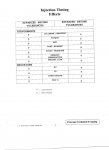We are starting to build a "Bonneville" engine for Casper's record attempt in 2009.
So this will be the diary of the engine.
First off, what is a Bonneville engine, and why does it have to be different? Well, we know now that a conventional drag/sled engine build will not survive land speed racing. We found that out the hard way when the engine and turbocharger melted on the backup record run.
A dyno pull lasts 6-8 seconds, a drag race will last 9-11 seconds, a sled pull might last 20 seconds. But a successful Bonneville run can last 90 seconds, most of it at high RPM. Cooling is more critical. Piston, head, and block temperatures cannot be allowed to keep climbing like we currently do. They must stabilize at a survivable level. And it must survive at least 2 passes minimum, or you are wasting your time. Things you can get away with, like high EGT's or oil temperature, for a short time will melt the engine if allowed enough time.
To achieve the speed we want (200+ mph) will take 900rwhp sustained for up to 90 seconds. This is something I do not believe has ever been done with a Duramax.
Our engine is starting out as a used LBZ engine, and currently resides at SoCalDiesel in the care of Guy Tripp. I like using used engines if possible to reduce the chance of a manufacturer's defect popping up. We are sending out the injectors to have them honed out for high RPM operation and precision matched. Your weakest cylinder will stop you, even if the other 7 are great. So getting all 8 cylinders on the same page is critical. A perfect engine is one that blows up all cylinders at the same time. We just blew up 2 cylinders in the last engine, but in all fairness, the other six were on death's doorstep ringing the bell like they had to use the bathroom.
Next will be careful disassembly, cleaning, and inspection, to insure we are starting with a good foundation.
I will continue to add to this thread until the engine is complete, tested, and run at Bonneville.
So this will be the diary of the engine.
First off, what is a Bonneville engine, and why does it have to be different? Well, we know now that a conventional drag/sled engine build will not survive land speed racing. We found that out the hard way when the engine and turbocharger melted on the backup record run.
A dyno pull lasts 6-8 seconds, a drag race will last 9-11 seconds, a sled pull might last 20 seconds. But a successful Bonneville run can last 90 seconds, most of it at high RPM. Cooling is more critical. Piston, head, and block temperatures cannot be allowed to keep climbing like we currently do. They must stabilize at a survivable level. And it must survive at least 2 passes minimum, or you are wasting your time. Things you can get away with, like high EGT's or oil temperature, for a short time will melt the engine if allowed enough time.
To achieve the speed we want (200+ mph) will take 900rwhp sustained for up to 90 seconds. This is something I do not believe has ever been done with a Duramax.
Our engine is starting out as a used LBZ engine, and currently resides at SoCalDiesel in the care of Guy Tripp. I like using used engines if possible to reduce the chance of a manufacturer's defect popping up. We are sending out the injectors to have them honed out for high RPM operation and precision matched. Your weakest cylinder will stop you, even if the other 7 are great. So getting all 8 cylinders on the same page is critical. A perfect engine is one that blows up all cylinders at the same time. We just blew up 2 cylinders in the last engine, but in all fairness, the other six were on death's doorstep ringing the bell like they had to use the bathroom.
Next will be careful disassembly, cleaning, and inspection, to insure we are starting with a good foundation.
I will continue to add to this thread until the engine is complete, tested, and run at Bonneville.
Last edited:



